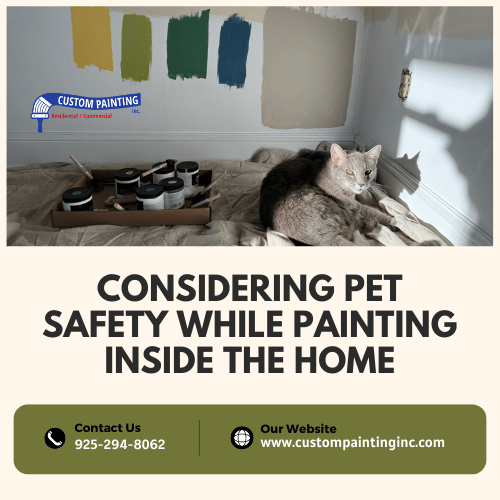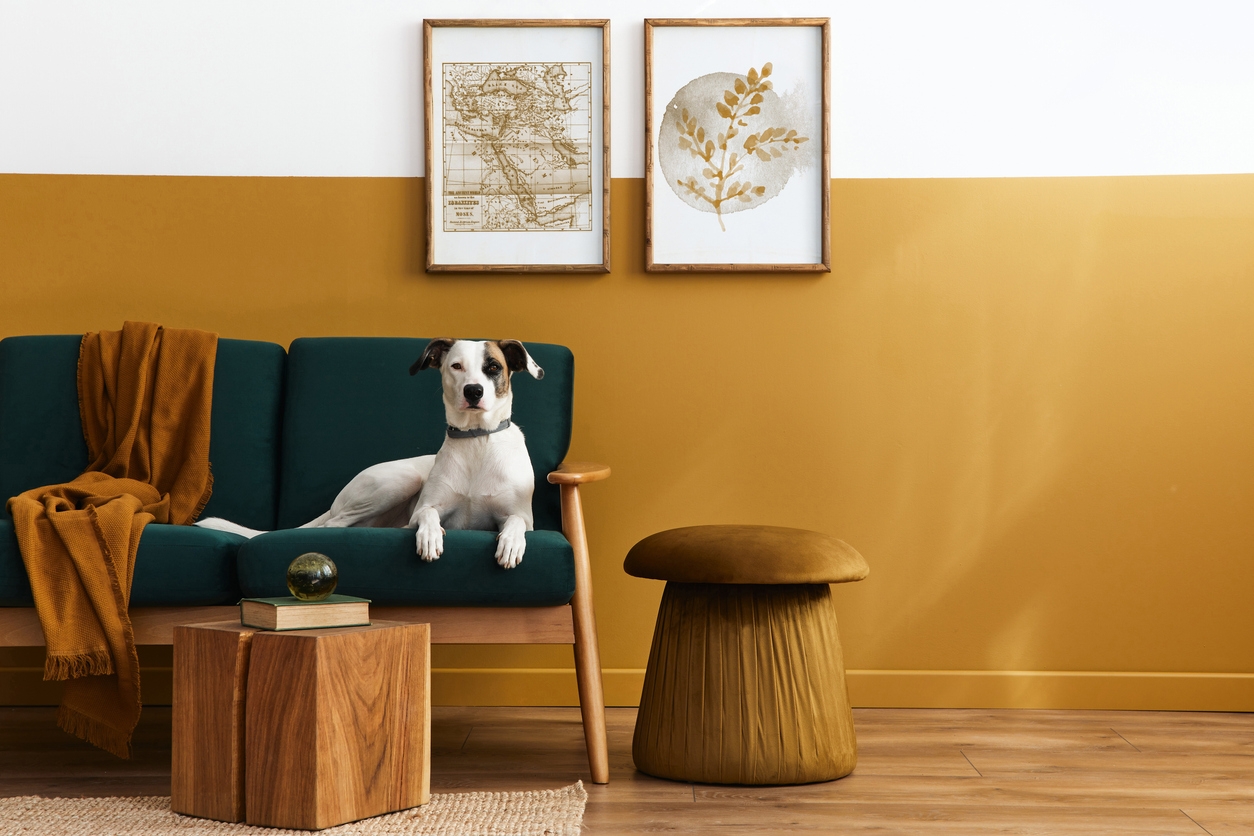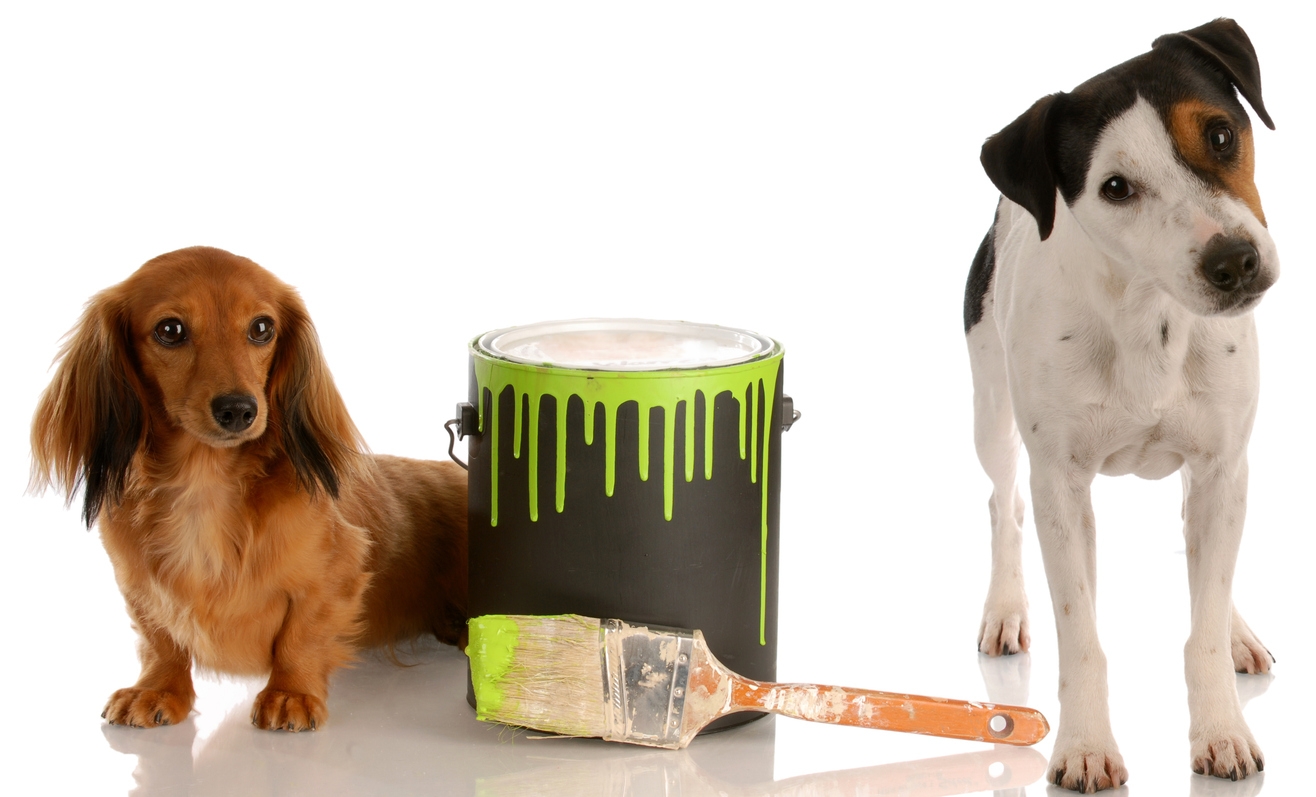If you’re a pet owner and want to refresh your home’s look with a fresh coat of paint, there are some safety precautions you have to take to keep them safe. Pets are naturally curious and love to explore, but this can lead to potential hazards when you’re in the middle of a painting project. It’s not just about making sure they don’t lean on the wet paint and get fur on your wall – there are health-related risks to exposing your pets to paint. So, when you’re preparing your house for indoor painting, take note of these tips to keep your furry friends safe and sound.
Potential Hazards for Pets
These are some of the reasons to take extra care when painting with pets:
There can be toxic fumes and chemicals in paint.
Many paints contain volatile organic compounds (VOCs) and other chemicals that can release toxic fumes. These fumes are harmful to humans and can be especially dangerous for pets. Animals have a more sensitive respiratory system; inhaling these fumes can lead to respiratory issues, dizziness, or even more severe health problems.
They might ingest paint or get in contact with it.
Pets are known for their curiosity, and they might sniff, lick, or even walk through wet paint. This can lead to ingestion of toxic substances, causing stomach upset or poisoning. Additionally, paint on their fur or skin can result in irritation or allergic reactions. It’s crucial to prevent any contact between your pets and the paint to avoid these risks.
They might wander and cause an accident.
With all the plastic, ladders, and supplies lying around, your curious pet might wander in, get in the way, and cause an accident that could hurt either you or them. Painting involves using many tools that might seem like toys to your pet, making it very tempting for them to chew on or even try to eat the paint supplies.
Choose Pet-Safe Paints
One way to keep your pet safe while you’re painting indoors is to choose the right paint. This is important for both your pets’ and your own safety.
Traditional paints come with VOCs, or volatile organic compounds, which are chemicals that can release harmful fumes into the air. Low-VOC and non-toxic paints are designed to minimize or eliminate these toxic substances, making them much safer for humans and pets.
When shopping for paint, look for labels that indicate low or zero VOCs. These products are better for indoor air quality and significantly reduce the risk of respiratory issues for your pets.
Several brands out there specialize in producing pet-safe, environmentally friendly paints. Brands like ECOS Paints, Benjamin Moore’s Natura line, and Sherwin-Williams Harmony line are all great options. These paints are formulated to be safer and healthier, with low emissions and fewer harmful chemicals. They come in a variety of colors and finishes, so you don’t have to compromise on aesthetics while ensuring the safety of your pets.
How to Prepare the Painting Area
Before you start painting, it’s essential to prepare the area to ensure your pets are safe and comfortable. Here’s how you can get everything set up:
1. Secure the area and keep pets away.
The first step in preparing your painting area is to secure it so your pets can’t wander in and get into trouble. Here are some simple steps you can follow:
- Choose a painting zone: Decide which rooms or areas you’ll paint and plan to keep your pets out of these spaces.
- Remove temptations: Make sure nothing in the painting area might attract your pets, like their toys or bedding.
- Set up a safe space: Create a comfortable, separate area for your pets to stay while you’re painting. This could be another room or even a friend’s house if possible.
- Communicate with family: Let everyone in your household know about the painting project and the plan to keep pets safe.
2. Ensure proper ventilation.
Proper ventilation is crucial when painting indoors, not only for your own health but also for your pets’ safety. Good ventilation helps disperse any fumes from the paint, making the air safer to breathe. Also, proper airflow can help the paint dry faster.
To ensure good ventilation, open windows and doors, and consider using fans to help circulate the air.
3. Use barriers and pet-safe gates.
If you can’t ensure that your pet won’t try to get to your painting area, keep them out by using barriers and pet-safe gates. You can also move furniture or set up screens to temporarily block off the area.
How to Manage Pets During the Painting Process
Once you’ve prepared the painting area, it’s time to think about how to manage your pets while you’re working. If you’re the pet’s primary caregiver, they will surely try to come to you while you work, so you have to keep them calm, occupied, and comfortable while you’re painting. These tips can help you reduce their anxiety and keep them out of the painting area. Here are some ideas:
- Provide toys and chews: Give your pets their favorite toys or new chews to keep them entertained.
- Give them interactive toys: Puzzle toys filled with treats can keep your pets engaged for longer periods.
- Play background noise: Playing soft music or leaving the TV on can create a soothing background noise that helps calm your pets.
Don’t forget to ensure your pets have everything they need within reach, like food, water, and comfortable bedding. In some cases, it might be best to arrange temporary accommodations for your pets to keep them safe and comfortable. Here’s how:
- Set up a safe room: Designate a room in your home where your pets can stay while you’re painting. Make sure it’s a space they’re familiar with and feel comfortable in.
- Use a pet sitter: If you’re painting a large area or multiple rooms, consider hiring a pet sitter or asking a friend or family member to look after your pets for the day.
- Consider pet boarding: For longer projects, you might want to consider pet boarding facilities where your pets can stay and be cared for.
Post-Painting Safety Measures
After you’ve finished painting, it’s important to take a few extra steps to ensure your pets remain safe and healthy. Here’s how to manage the post-painting process to protect your furry friends.
1. Let the paint dry completely first before allowing them to go into the area.
Always keep the area off-limits until the paint is completely dry. Even low-VOC paints can release some fumes while drying. Allowing sufficient drying time ensures these fumes dissipate, reducing the risk of respiratory issues for your pets. Also, it’s better to avoid getting wet paint smudged or ingested by curious pets.
2. Clean up thoroughly.
A thorough cleanup is essential to ensure there are no leftover hazards for your pets. Here are some steps to follow:
- Remove paint cans and brushes: Immediately put away paint cans, brushes, rollers, and other tools. Store them in a place your pets can’t access.
- Clean surfaces: Wipe down any surfaces that may have come into contact with paint, including floors, countertops, and furniture.
- Ventilate again: Continue to ventilate the area by keeping windows open and using fans. This helps to clear out any remaining fumes and speed up the drying process.
- Dispose of waste properly: Follow local guidelines to dispose of paint-soaked rags, painter’s tape, and other waste materials safely.
3. Monitor pets for any signs of distress or reactions.
Even with the best precautions, it’s important to keep an eye on your pets after the painting project is complete. Here’s what to look out for and when to seek help:
- Coughing and sneezing: These could be signs that your pet has inhaled fumes or particles from the paint.
- Skin irritation: Redness, itching, or swelling on your pet’s skin may indicate contact with paint.
- Vomiting or diarrhea: These symptoms can occur if your pet has ingested any paint.
- Lethargy: If your pet seems unusually tired or less active than normal, it might be a reaction to paint exposure.
- Behavioral changes: Any sudden changes in behavior, such as increased agitation or withdrawal, can be a sign of distress.
If you notice any of these symptoms, it’s best to contact your veterinarian for advice. They can help determine whether your pet needs treatment and what steps you should take. It’s always better to be cautious, especially when dealing with potential exposure to chemicals.
Conclusion
Your pets are part of your family, and their safety is a top priority. By taking these steps and choosing pet-safe products, you can protect them from potential hazards and create a healthier home environment.
For professional advice and pet-safe painting services, contact Custom Painting, Inc. Our experienced team can help you choose the right products and ensure a safe, beautiful result for your home. Prioritize your pets’ safety and call us at 925-866-9610 for a consultation. You can also complete the online form, and we’ll get back to you.



